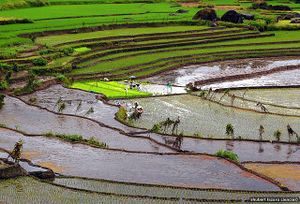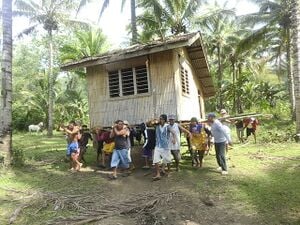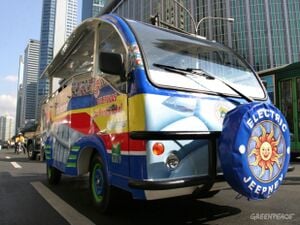
The aim of this page is to recognise, celebrate and encourage the self-empowerment of community agency networks (CANs) and community groups' activism for climate, environment and many other sustainability topics across the Philippines.
 ‘Forest pharmacy’ kept standing by traditional healers in Philippines, news.mongabay.com (Feb 09, 2024)
‘Forest pharmacy’ kept standing by traditional healers in Philippines, news.mongabay.com (Feb 09, 2024)  Pala’wan Indigenous community’s organic farming protecting a Philippine hotspot, news.mongabay.com (Nov 16, 2023)
Pala’wan Indigenous community’s organic farming protecting a Philippine hotspot, news.mongabay.com (Nov 16, 2023)  Community spirit and organic farming buoy a typhoon-battered Philippine town, news.mongabay.com (May 15, 2023)
Community spirit and organic farming buoy a typhoon-battered Philippine town, news.mongabay.com (May 15, 2023)
Networks and sustainability initiatives[edit | edit source]
Food activism[edit | edit source]
Community pantries in the Philippines are food banks established by Filipinos during the country's COVID-19 community quarantine.
On April 14, 2021, local entrepreneur Ana Patricia Non worked with farmers and local vegetable vendors to put up a small food bank for her community on Maginhawa Street in Quezon City, putting up a sign that invited people to "give according to your ability, take according to your need." The initiative caught the attention of Filipinos on social media, creating a "snowball effect", with citizens putting up their own pantries in their communities and inspiring people from other countries do the same.
Initiated without any government support, some of the community pantries and their organizers were initially interrogated and red-tagged by National Task Force to End Local Communist Armed Conflict (NTF-ELCAC) spokesperson Lt. Gen. Antonio Parlade Jr. and Presidential Communications Undersecretary Lorraine Badoy-Partosa as possible sympathizers and recruiters of insurgent left-wing militant organizations.
By April 20, 2021, press reports noted that there were already more than a hundred citizen-organized community pantries throughout the Philippines. On April 22, the Philippine Daily Inquirer reported that there were already at least 350 such pantries throughout the country.
Sharing[edit | edit source]

Bayanihan (IPA: [ˌbajɐˈnihan]) is a Filipino term taken from the word bayan, referring to a nation, country, town or community. The whole term bayanihan refers to a spirit of communal unity or effort to achieve a particular objective. It is focused on doing things as a group as it relates to one's community.
The origin of the term bayanihan can be traced from a common tradition in Philippine towns where community members volunteer to help a family move to a new place by volunteering to transport the house to a specific location. The process, which is the classic illustration of the term, involves literally carrying the house to its new location. This is done by putting bamboo poles forming a strong frame to lift the stilts from the ground and carrying the whole house with the men positioned at the ends of each pole. The tradition also features a small fiesta hosted by the family to express gratitude to the volunteers.
In society, bayanihan has been adopted as a term to refer to a local civil effort to resolve national issues. One of the first groups to use the term is the Bayanihan Philippine National Folk Dance Company which travels to countries to perform traditional folk dances of the country with the objective of promoting Philippine culture. The concept is related to damayán ("to help one another").
In computing, the term bayanihan has evolved into many meanings and incorporated as codenames to projects that depict the spirit of cooperative effort involving a community of members. An example of these projects is the Bayanihan Linux project which is a Philippines-based desktop-focused Linux distribution.
In ethnic newspapers, Bayanihan News is the name of community newspaper for the Philippine community in Australia. It is in English and in Filipino with regular news and articles on Philippine current events and history. It was established in October 1998 in Sydney, Australia. W
Climate action[edit | edit source]
Activist groups associated with the climate movement have called for government action and have organized activities to raise public awareness on climate and related environmental, sociopolitical, and economic issues. Philippine activists have, for example, taken part in the global climate strike, joining demands for political leaders to urgently address the climate emergency.
Below are some protest actions and social movements associated with climate change in the Philippines.
- In 2021, activists stood outside the Standard Chartered office to protest the bank's funding of the coal industry. Standard Chartered is the biggest funder of the coal industry in the Philippines.
- As part of its policy advocacy, Greenpeace Philippines released an open letter in 2019 urging President Rodrigo Duterte to declare a climate change emergency to make climate change and its impacts a top government priority.
- The Catholic Bishops' Conference of the Philippines issued a pastoral letter in 2019 instructing dioceses to make caring for the environment a special concern in the face of the climate emergency.
- Fisherfolk organization Pambansang Lakas ng Kilusang Mamamalakaya ng Pilipinas (Pamalakaya) protested in Mendiola in 2020 to urge the Philippine government to address the impacts of climate change on fisherfolk. The group also called for an end to reclamation projects to preserve the marine ecosystem and protect millions of people from flooding and dislocation.
- Kalikasan People's Network for the Environment joined the 2015 International Human Rights Day protests to raise concern over the plight of climate refugees.
- Peasants, fisherfolk, Indigenous peoples, and other grassroots communities organized various protests in 2015 calling on government to end large-scale mining projects and address the root causes of the climate crisis. W
Mitigation and adaptation
Renewable energy in the Philippines is being expanded including with offshore wind power. A Pulse Asia survey conducted in 2018 revealed that 97% of energy consumers in Metro Manila favor the utilization of renewable energy. The government is making an adaptation plan.
Mangrove forests have proven to be an efficient and environmentally friendly solution to the effects of coastal hazards. Extensive mangrove rehabilitation projects have been undertaken in the Philippines.
Recognizing the Philippines' considerable disaster risk, there is need for disaster risk reduction and preparedness as well as humanitarian relief efforts. The Philippines institutionalizes the humanitarian cluster approach, and it organises disaster relief through its National Disaster Risk Reduction and Management Council (NDRRMC). NDRRMC also oversees the 18 regional Disaster Risk Reduction Management Councils (LDRRMCs), which in turn supervise disaster risk reduction and management operations at the provincial, city, and barangay levels (barangay is the lowest level of government, similar to the "village" level).
On March 11, 2024, the Department of Environment and Natural Resources' Toni Yulo-Loyzaga and the European Union launched the €60 million (P3.67 billion) "Green Economy Programme for the Philippines" in the form of a grant from 2023 to 2028 to mitigate environmental degradation and combat climate change to foster economic growth and social inclusivity. "The successful launch of the Green Economy Programme for the Philippines is part of the EU's new Global Gateway Strategy and shows our commitment worldwide to combating climate change while promoting inclusive economic development," EU Ambassador Luc Véron said. W
Climate change in the Philippines
Climate change is having serious impacts in the Philippines such as increased frequency and severity of natural disasters, sea level rise, extreme rainfall, resource shortages, and environmental degradation. All of these impacts together have greatly affected the Philippines' agriculture, water, infrastructure, human health, and coastal ecosystems and they are projected to continue having devastating damages to the economy and society of the Philippines.
According to the UN Office for the Coordination of Humanitarian Affairs (OCHA), the Philippines is one of the most disaster-prone countries in the world. The archipelago is situated along the Pacific Ocean's typhoon belt, leaving the country vulnerable to around 20 typhoons each year, a quarter of which are destructive. The December 2021 typhoon known colloquially as Typhoon Odette caused around a billion dollars (₱51.8 billion) in infrastructure and agricultural damages and displaced about 630,000 people. The United Nations estimated that Typhoon Odette impacted the livelihoods of 13 million people, destroying their homes and leaving them without adequate food or water supplies. More tragically, the physical and economic repercussions of Typhoon Odette led to the death of over 400 people as of December 2021.
In addition to the Philippines' close proximity to the Pacific Ocean's typhoon belt, the Philippines is also located within the "Pacific Ring of Fire" which makes the country prone to recurrent earthquakes and volcanic eruptions. Compounding these issues, the impacts of climate change, such as accelerated sea level rise, exacerbate the state's high susceptibility to natural disasters, like flooding and landslides. Aside from geography, climate change impacts regions with a history of colonization more intensely than regions without a history of colonization. Colonized regions experience the repercussions of climate change most jarringly "because of their high dependence on natural resources, their geographical and climatic conditions and their limited capacity to effectively adapt to a changing climate." Since low-income countries have a history of colonialism and resource exploitation, their environment lacks the diversity necessary to prevail against natural disasters. A lack of biodiversity reduces the resilience of a specific region, leaving them more susceptible to natural disasters and the effects of climate change. With its history of Spanish colonization, the Philippines is not environmentally nor economically equipped to overcome issues it is currently dealing with, such as natural disasters and climate change. This inability to recover exacerbates the problem, creating a cycle of environmental and economic devastation in the country.
Biodiversity[edit | edit source]
The wildlife of the Philippines includes a significant number of endemic plant and animal species. The country's surrounding waters reportedly have the highest level of marine biodiversity in the world. The Philippines is one of the seventeen megadiverse countries and is a global biodiversity hotspot. In 2013, 700 of the country's 52,177 species were listed as threatened.
The Philippines has among the highest rates of species discovery in the world with 16 new species of mammal discovered in the last ten years. Because of this, the degree of endemism in the Philippines has risen and will likely continue to rise.
Some of the smallest and largest animals and plants are found in the Philippines. These include the smallest primate (tarsier), the biggest moth (Atlas moth, or mariposa in Tagalog), the smallest deer (Philippine mouse-deer or pilandok), the smallest fish (Philippine goby), and the biggest fish (whale shark).
Coastal community activism[edit | edit source]
Marine Conservation Philippines, registered non-governmental organization dedicated to preserving and protecting coastal resources in the Philippines through education, volunteerism and research. The organization engage local communities and policy makers and work to ensure solutions that will benefit both man and nature in the long run. added 20:38, 3 November 2021 (UTC)
The Philippines's surrounding waters reportedly have the highest level of marine biodiversity in the world. W
Sustainable transport activism[edit | edit source]
About the Philippines[edit | edit source]
The Philippines, officially the Republic of the Philippines, is an archipelagic country in Southeast Asia. In the western Pacific Ocean, it consists of 7,641 islands, with a total area of roughly 300,000 square kilometers, which are broadly categorized in three main geographical divisions from north to south: Luzon, Visayas, and Mindanao. The Philippines is bounded by the South China Sea to the west, the Philippine Sea to the east, and the Celebes Sea to the south. It shares maritime borders with Taiwan to the north, Japan to the northeast, Palau to the east and southeast, Indonesia to the south, Malaysia to the southwest, Vietnam to the west, and China to the northwest. It is the world's twelfth-most-populous country, with diverse ethnicities and cultures. Manila is the country's capital, and its most populated city is Quezon City. Both are within Metro Manila.
Near you[edit | edit source]

